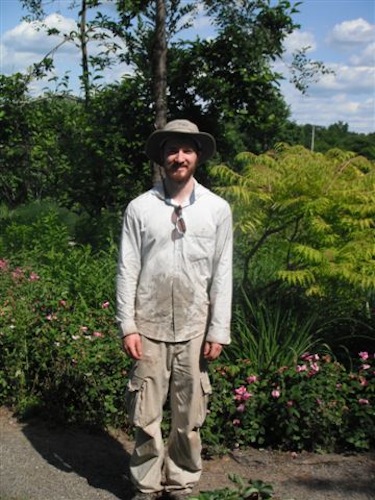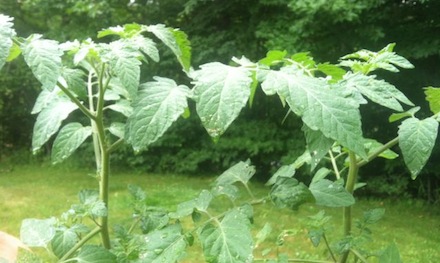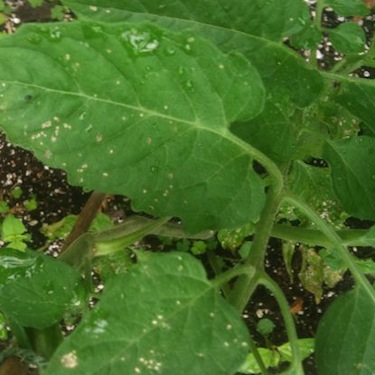
AgriCulture bloggers Peter Davies and Mark Scherzer are the owners of Turkana Farms in Germantown, NY. This week, Peter writes: It is Wednesday, an indoor day. The heat is pushing at the window panes. The pigs are hardly interested in eating. And the geese are busier at their waterer than with the grasses and weeds that usually occupy them. The sheep, which fortunately were sheared a few weeks ago, have been given the alternative of camping out on the coolness of the barn concrete floor, and are taking full advantage of it. Our farm helper, Darlene, who does not handle heat and humidity well, has taken the day off, while Eli, our new helper (in photo, left), has gotten through the morning but is now having a siesta on the coolness of our kitchen floor. I feel fortunate to have gotten my farm chores over early and am now taking refuge under the ceiling fan of the farm office.

Nevertheless, on the whole, the house is amazingly cool given the oppressive heat and humidity outdoors. We have no air conditioning but are profiting from an old Dutch practice. The walls of the house, which had its start sometime in the second half of the 18th century, are lined with “noggins.” In the space between the clapboarding and the lathe and plaster is a wall of bricks placed on their edges, and, therefore, called “noggins,” walling up the interstices between the studs. This heavy-duty form of insulation keeps the heat and cold out (as well as acting as a very effective sound barrier).

So we get by quite well with just ceiling fans in the upstairs rooms. And we could get by even better if we moved entirely into the old “homestead” part of the house, the original 18th century English basement room that served as kitchen, dining room, and living room in the days when the house consisted only of this common room, and a sleeping loft above. The homestead kitchen was sensibly dug half into the ground and rests on the level of the shale outcropping that forms the platform on which the foundations of the house and its old barn sit. In summer this common room is super “air conditioned,” almost chilly, and in winter it is draft-free and super-snug, especially when the cooking hearth is blazing away. But hearing, given today’s heat, that something is “blazing away” only makes me want to change the subject.

In the vegetable garden Eli has been moving the sprinkler around all morning, focusing on keeping the newly planted beds wet and cool. And in particular giving cooling baths to the favas, which have just started to bear. The favas, which have thrived in the cool, wet days we have had for some weeks, seem to suffer from the heat even more than I do, and are even more sensitive than peas to overly hot temperatures. A few days of unremitting heat mean that the fava plants, no matter how far along they might be, give up, wilt, and die. Most plants when stressed usually, it seems to me, push on to the end to bear fruit and hence seeds, no matter what else happens to the rest of the plant. But not favas. However, what is death to the favas is life to okra. Vegetables, like people, seem to have very different needs. In contrast to the favas, our okra seedlings have languished these past weeks and look pale, yellowish, and frail, this because of our unusually cool evenings and mildly warm days. As a native of Africa, okra needs very hot days and nights, and if it does not get such temperatures, it, like favas, will wilt and die—but for very different reasons. We have, in fact, had a few disappointing summers in which okra never managed to reach the fruiting stage and gradually closed down before the end of summer – but not lately.

These hot days are also probably being welcomed by the tomatoes. The recent stretches of cool, rainy, overcast days unfortunately have created ideal conditions for the tomato blight that so decimated the tomato crop in these parts a few years ago. I have been checking daily for the tell-tale yellow/brown speckled leaves. And I have been looking even more intensely since I have heard of some fungus problems already attacking tomatoes in our general region.

I have been so concerned about the possibility of the blight returning to our tomato patch that I held off mulching the tomatoes until yesterday. The drier the ground around the tomato plants and the more open they are to breezes, the better chance the plants have to escape the blight, which thrives on dampness. But the weed problem we have at Turkana Farms really dictates heavy mulching. With these hot, sunny days now upon us, mulching now seems like more of a safe bet. The basil, like the okra, also has languished and has a pale, anemic look, because, I believe, of the cool nights. The same conditions seem to have also held the cucumbers back. So while we would, if we could, keep this hot weather in abeyance, we would do so to the detriment of many of our edibles. I often think of these consequences when I read about futuristic schemes to create huge biospheres encasing the cities and countryside as a strategy for controlling the temperatures and creating ideal, supposedly livable, conditions. Who, I wonder, would be in charge of setting the controls? And to please whom? How would all the varied needs of the population be satisfied? To say nothing of all the varied needs of the vegetables and livestock that we so depend on. Better (that is, if we do not senselessly destroy her) to let unpredictable and erratic Mother Nature handle things. —Peter Davies









